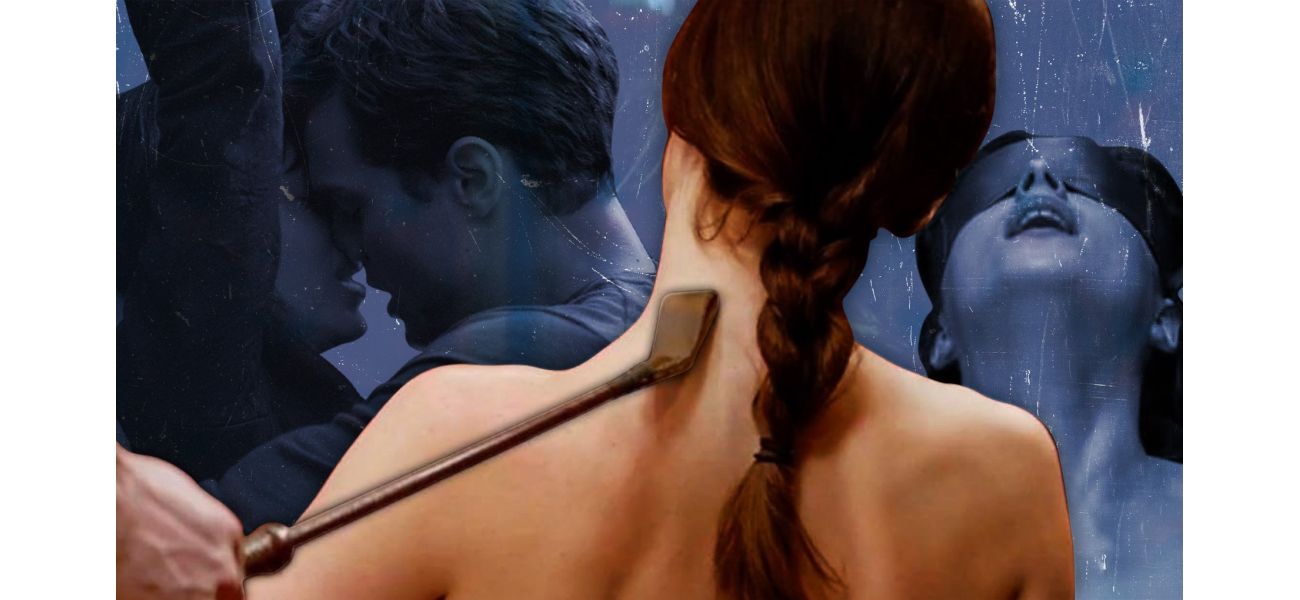Fifty Shades of Grey caused a stir with its explicit content, and it has been ten years since its release.
A successful movie with a lot of nudity.
February 13th 2025.

It was back in 2015 when Fifty Shades of Grey took the world by storm. With Taylor Swift and Katy Perry feuding, Uptown Funk topping the charts, and the highly anticipated film adaptation of E L James' bestselling novel hitting the big screens, it was a time of excitement and controversy.
For some, the R-rated movie was a long-awaited climax, bringing to life the sexual fantasies sparked by the Twilight-fanfiction-turned-erotic-BDSM-novel. It grossed a staggering £468,780,145 and even caused a woman in Milton Keynes to reportedly "erotically soil" herself in the back of a Cineworld theater. But for others, it was a disappointment and a cause for concern.
Critics slammed the film for glamorizing an abusive relationship, with one viewer stating that "the fine line between abuse and pleasure is so thin it's almost non-existent." And in the wake of the film's release, the use of the "rough sex defense" - where perpetrators use BDSM as an excuse for their violent actions - was coined as the "Fifty Shades defense." This defense has been used in court an estimated 60 times in the UK alone, perpetuating the harmful belief that women who engage in rough sex are asking for violence.
One such tragic case involved 21-year-old Grace Millane, who was strangled to death by her killer who claimed that she had begged him to recreate BDSM scenes from Fifty Shades of Grey. This sparked a heated debate about the impact of the movie's portrayal of BDSM and its potential to normalize abusive behavior.
Despite its flaws, Fifty Shades of Grey garnered a massive fan base, especially among women. Jennifer Walderdorff, a 39-year-old mother and sustainable fashion consultant, was one of them. She watched the movie when it first came out and loved it. "I enjoyed the fact that it was salacious," Jennifer tells Metro. "It was a story about sex and people talked about it under their hands. It was naughty and people would whisper 'I'm going to see Shades of Grey.' I found it hilarious."
For Jennifer, the film was also freeing and opened up discussions about kink and sexual exploration. "It brought up the discussion of toys, there were floggers and blindfolds, hair braids and rope binding your arms, there were also positions like doggy style," she shares. "The movie put those things on the table to talk about, and people were more inclined to listen."
Jennifer was in a long-term relationship when she watched the film and felt inspired to become more theatrical in the bedroom, upgrading her lingerie and trying out the "stand and carry" sex position with her partner. "There's a scene in the movie where Christian also does this, good thing I was more athletic back then, because now I'd need a forklift," she jokes.
But while some saw the film as just a form of escapism, others were concerned about its portrayal of an abusive relationship. Award-winning intimacy coordinator Ita O'brien, who has worked on movies such as Normal People, believes that Fifty Shades of Grey failed to draw the line between consensual sexual exploration and an abusive relationship dynamic. "All gamuts of our intimate expression should be captured on screen because it's a reflection of us," she explains. "But if something is abusive intimate content, it shouldn't be made to seem sex positive and empowered because that can be really damaging."
This blurred line between abuse and BDSM is a major concern for Finn Mackey, a sociologist who believes that the franchise normalizes sexual violence against women by turning it into entertainment marketed as "edgy and exciting." He explains that the film portrays women as inherently masochistic and perpetuates harmful beliefs about consent and male violence against women.
Lawyer Marcus Johnstone of PCD Solicitors also notes a rise in the number of allegations of rape and sexual assault associated with BDSM and the "rough sex defense." He believes that books and films like Fifty Shades have contributed to the idea that women may want sex even when they say no, making it easier for perpetrators to use this as an excuse in court.
But for Jennifer, the film is not to blame for these societal issues. She believes that it should be allowed to remain as a form of escapism and not be compared to real life. "Movies can imitate reality, but it's not always necessary that they should be compared to real life," she asserts.
The impact of Fifty Shades of Grey is still being debated a decade after its release. While some see it as a harmless form of entertainment, others are concerned about its potential to normalize abusive behavior and perpetuate harmful beliefs about consent and relationships. The discussion surrounding the film serves as a reminder of the power and responsibility of media in shaping societal attitudes and beliefs.
For some, the R-rated movie was a long-awaited climax, bringing to life the sexual fantasies sparked by the Twilight-fanfiction-turned-erotic-BDSM-novel. It grossed a staggering £468,780,145 and even caused a woman in Milton Keynes to reportedly "erotically soil" herself in the back of a Cineworld theater. But for others, it was a disappointment and a cause for concern.
Critics slammed the film for glamorizing an abusive relationship, with one viewer stating that "the fine line between abuse and pleasure is so thin it's almost non-existent." And in the wake of the film's release, the use of the "rough sex defense" - where perpetrators use BDSM as an excuse for their violent actions - was coined as the "Fifty Shades defense." This defense has been used in court an estimated 60 times in the UK alone, perpetuating the harmful belief that women who engage in rough sex are asking for violence.
One such tragic case involved 21-year-old Grace Millane, who was strangled to death by her killer who claimed that she had begged him to recreate BDSM scenes from Fifty Shades of Grey. This sparked a heated debate about the impact of the movie's portrayal of BDSM and its potential to normalize abusive behavior.
Despite its flaws, Fifty Shades of Grey garnered a massive fan base, especially among women. Jennifer Walderdorff, a 39-year-old mother and sustainable fashion consultant, was one of them. She watched the movie when it first came out and loved it. "I enjoyed the fact that it was salacious," Jennifer tells Metro. "It was a story about sex and people talked about it under their hands. It was naughty and people would whisper 'I'm going to see Shades of Grey.' I found it hilarious."
For Jennifer, the film was also freeing and opened up discussions about kink and sexual exploration. "It brought up the discussion of toys, there were floggers and blindfolds, hair braids and rope binding your arms, there were also positions like doggy style," she shares. "The movie put those things on the table to talk about, and people were more inclined to listen."
Jennifer was in a long-term relationship when she watched the film and felt inspired to become more theatrical in the bedroom, upgrading her lingerie and trying out the "stand and carry" sex position with her partner. "There's a scene in the movie where Christian also does this, good thing I was more athletic back then, because now I'd need a forklift," she jokes.
But while some saw the film as just a form of escapism, others were concerned about its portrayal of an abusive relationship. Award-winning intimacy coordinator Ita O'brien, who has worked on movies such as Normal People, believes that Fifty Shades of Grey failed to draw the line between consensual sexual exploration and an abusive relationship dynamic. "All gamuts of our intimate expression should be captured on screen because it's a reflection of us," she explains. "But if something is abusive intimate content, it shouldn't be made to seem sex positive and empowered because that can be really damaging."
This blurred line between abuse and BDSM is a major concern for Finn Mackey, a sociologist who believes that the franchise normalizes sexual violence against women by turning it into entertainment marketed as "edgy and exciting." He explains that the film portrays women as inherently masochistic and perpetuates harmful beliefs about consent and male violence against women.
Lawyer Marcus Johnstone of PCD Solicitors also notes a rise in the number of allegations of rape and sexual assault associated with BDSM and the "rough sex defense." He believes that books and films like Fifty Shades have contributed to the idea that women may want sex even when they say no, making it easier for perpetrators to use this as an excuse in court.
But for Jennifer, the film is not to blame for these societal issues. She believes that it should be allowed to remain as a form of escapism and not be compared to real life. "Movies can imitate reality, but it's not always necessary that they should be compared to real life," she asserts.
The impact of Fifty Shades of Grey is still being debated a decade after its release. While some see it as a harmless form of entertainment, others are concerned about its potential to normalize abusive behavior and perpetuate harmful beliefs about consent and relationships. The discussion surrounding the film serves as a reminder of the power and responsibility of media in shaping societal attitudes and beliefs.
[This article has been trending online recently and has been generated with AI. Your feed is customized.]
[Generative AI is experimental.]
0
0
Submit Comment





